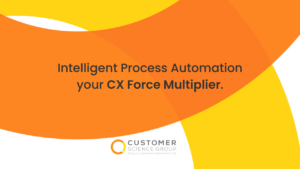Reflecting on the insights shared at last month’s Customer Experience (CX) Show in Melbourne and in anticipation of the upcoming show in Sydney this August – The Customer Show | Australia’s Largest CX Expo, it’s clear that while process automation has become a pivotal aspect of modern business operations – particularly in the back-office, there is still plenty of untapped opportunity in the front-office, where your customer-facing activities take place.
Automating across the front and back office helps take the customer experience to the next level by unifying the organisation to work more effectively for your customer.
Most back-office processes are perfect for automation, especially those which have high-volume & low complexity, deal with structured data, and involve a limited number of exceptional circumstances. Data entry, reporting processes, maintaining inventory, and maintaining paperwork are such processes that can be highly efficient with back-office automation.
Front-office automation aims to imitate human interaction. Modern, Generative AI-based Chatbots and Communications Mining tools are now capable of accelerating the turnaround time and improving the customer experience for a wide range of increasingly complex, customer facing business processes.
So how and where should you start? You should be ‘ Working Backwards ‘ to appropriate and misquote a well-known Amazon idea.
At Amazon, Working Backwards is a systematic way to vet ideas and create new products and services. Its key tenet is to start by defining the customer experience, then iteratively work backwards from that point until the team achieves clarity of thought around what to build.
In the context of Intelligent Process Automation, you should start with the customer, and their touchpoints and identify where the points of friction exist with your organisation.
- Understand Your Customer: The first step is to truly understand your customer. Conduct research to understand their needs, preferences, pain points, and what they value in their interactions with your company. This might involve surveys, interviews, focus groups, and analysis of customer data and feedback.
- Map the Customer Journey: Identify all the touchpoints between the customer and your business and understand the customer’s journey from their perspective. This includes their initial discovery of your brand, their consideration and decision process, the purchasing experience, and their post-purchase experiences (such as product usage, customer service interactions, etc.).
- Identify Pain Points: Once the customer journey is mapped, identify areas where customers experience frustration, confusion, or inconvenience. These are your opportunities for improvement.
- Set Clear Objectives: Based on the identified pain points, set clear objectives for what you want to achieve with your CX-led automation initiative. This might be reducing wait times, improving first-contact resolution, increasing customer satisfaction scores, etc.
Once you understand where the pain is, you can map the process starting with the customer experience all the way through to the back-office process responsible for delivering the product or service to the customer.
When you link the front and back-office together through automation you get a force-multiplier effect. The vast majority of customer enquiries can then be dealt with efficiently and effectively, dramatically improving business outcomes.
For example, AI-based Chatbots can now instantly handle most routine inquiries, whether complex or not, reducing wait times. Banks use them to handle queries about account balances, and transaction history, and even to guide customers through simple processes like resetting passwords right through to completing mortgage applications. This immediate, 24/7 response capability significantly improves the customer experience, fostering customer satisfaction and loyalty.
The competitive advantages offered by AI and Automation are accelerating the rate of adoption. AI will become deeply embedded in the daily operations of a surging number of companies — a shift that will fundamentally alter how market share is distributed, which products and services are available to customers and how companies position themselves in the world.
Where are your customer’s pain points? What opportunities are there in your unique context? How will you stand out from the competition?
If you’re keen to bounce around some ideas of your own, use the form below to connect with the Automation team.
Written by Bart Thomas
